Equipment
Practical Use of Field Curvature: Wide and Telephoto Primes

We introduced evaluating field curvature with 35mm f/1.4 lenses, then looked at how those differ from slower 35mm primes and zooms at the same focal lengths. Then we got into some practical stuff, showing how field curvature gives you useful information for 50mm lenses.
Today we’re going to look at 24mm and 85mm prime lenses for a couple of reasons. First, I’m curious as to whether there is more curvature in wider lenses and less in telephoto. Second, I wonder if we can make some generalities about field curvature at various focal lengths.
In case you weren’t around for the first articles in this series, I would recommend not joining in right here; this is geeky stuff, and I’m not going to repeat all the ‘what this is’ from the previous articles. At least scan the first article, so you know what you’re looking at.
Today, we’re just going to show the fields wide open and at f/5.6 for each lens with a few comments and a summary.
24mm Lenses
Canon 24mm f1/.4 L Mk II
This makes an excellent first choice for a couple of reasons. First, looked at wide open, the sharpness is low at this resolution, and the field curvature is not obvious.

Lensrentals.com, 2020
Once we stop down, the curvature becomes apparent, and it’s more complex than the lenses we saw at other focal lengths. To clarify, the curvature doesn’t change as we stop down; it’s just easier to see now. (In other words, it’s easy to tell sharp from soft, but it’s hard to tell not sharp from soft.)

Lensrentals.com, 2020
The sagittal curve is a nice swoopy “M” shape. The tangential is an upside-down W or the Bat Signal or something complex. You can also see that even at f/5.6, the tangential field doesn’t sharpen up in the outer 1/3 of the image. In summary, the sagittal field, even at f/5.6, is going to be on a different plane of focus in the middle 1/3 of the image. The tangential field is going to be less sharp in the outer 1/3.
To try to stop the inevitable 4,000 ‘but mine is amazing in the corners’ comments: I didn’t say awful, it’s really quite good. I said less sharp, and it is less sharp.
Nikon 24mm f/1.4 G
We see a very similar pattern with the Nikon 24mm lens.
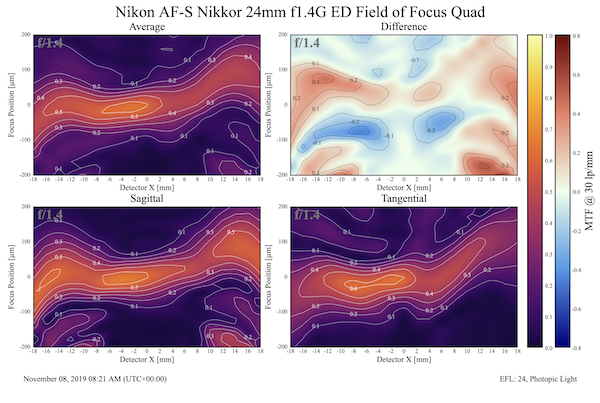
Lensrentals.com, 2020
The Nikon’s sagittal fields have a bit more complex upside-down “W” curve, and the tangential is a more crazy Batsignal with even weaker edges than the Canon’s.

Lensrentals.com, 2020
Before we continue, I should mention these are both really good 24mm lenses. But historically, designing wide-aperture, wide focal-length lenses is difficult, and I think the field plots show this.
Zeiss Milvus 25mm f/1.4
This is a much newer design than the first two lenses, and perhaps is showing us what recent advances in design, lens shaping, and glass mixtures have accomplished. Or maybe it’s just showing us that Zeiss is really good at wide-angle design.
Wide-open it’s a bit sharper than the first two lenses, and you get the impression the field is less dramatically curved.

Lensrentals.com, 2020
Stopped down the curvature is clearly less dramatic. The sagittal is a nice, gentle curve. The tangential is a broad “U” shape, although there’s a bit of waviness that makes me think a lot of work went into wrestling the Batsignal curve into something flatter.

Lensrentals.com, 2020
Sigma 24mm f/1.4 Art
The Sigma 24mm Art is a fresher design than the Canon or Nikon versions, not entirely as new as the Zeiss.
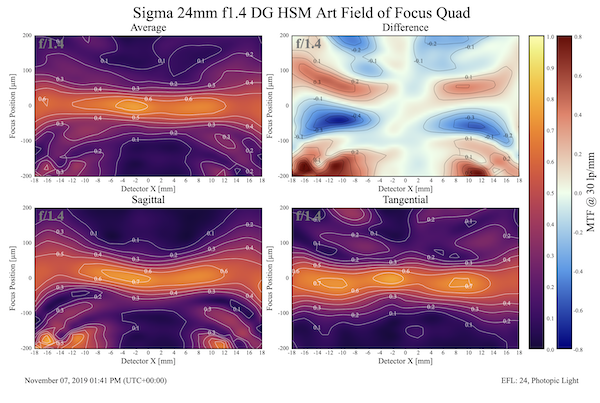
Lensrentals.com, 2020

Lensrentals.com, 2020
The field curvature isn’t as busy as the Canon or Nikon lenses, but they don’t overlap well. If you look at the Difference graph, you see that right along the plane of focus, things are matched up well (and the lens is very sharp). The foreground and background are very astigmatic, however, and I would expect out-of-focus highlights to be inconsistent.
Sigma 28mm f1.4 Art
This one isn’t quite 24mm, but I wanted to take a look at it since it’s a much newer design. It is clearly sharper wide open (it’s one of the sharpest wide angles we’ve tested), but overall the fields are very similar to the 24mm Art.

Lensrentals.com, 2020
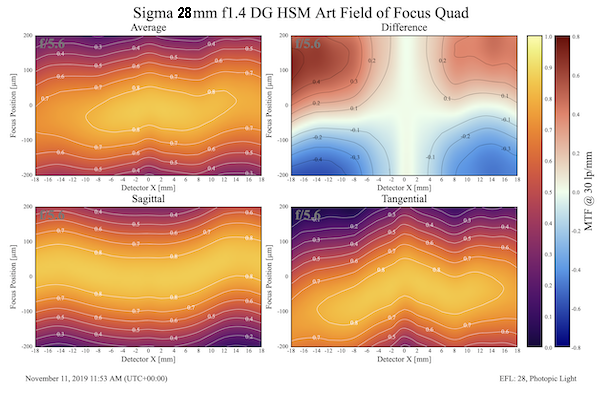
Lensrentals.com, 2020
Sony 24mm f1.4 GM
This was one I was very interested in. It’s a new design, widely praised, and well, Sony does things differently sometimes.

Lensrentals.com, 2020
As far as field curvature goes, though, they didn’t do things very different this time. The tangential field has the Batsignal curve, although you can see it has a higher resolution.

Lensrentals.com, 2020
Canon 24mm f2.8 IS
Finally, I thought we’d take a look at a good ‘consumer-grade’ 24mm lens. We found with the 35mm lenses that consumer-grade stopped down to f/5.6 was generally close to, but not as good as, the wide-aperture, pro-level primes.

Lensrentals.com, 2020

Lensrentals.com, 2020
That’s about what we find with the 24mm primes too. At f5.6, the tangential field is soft away from the center at f/5.6, but it’s decent.
But Wait, There’s More About 24
I know what you’re thinking; “Roger, I kind of see some patterns in these field curvatures at 24mm.” Yes, my friend, you are correct. For me, there are two distinct groupings. The first is what I’ll call ‘Classic 24mm’; an M to W shaped sagittal field, and a tangential field that bounces all over the place.
The Sony, has flattened out the sagittal field compared to the others, but the characteristic tangential is still there.

Lensrentals.com, 2020
The Zeiss and Sigma lenses, though, have flattened the tangential field. You still sense the underlying pattern, but it’s not quite so all over the place.

Lensrentals.com, 2020
The takeaway, for right now, is that stopped down, I would expect the first three lenses to have a similar look as far as field curvature, and astigmatism go. I would also expect the Zeiss and Sigmas to be fairly similar to each other, and somewhat different than the first group.
All 6 of these lenses have similar center sharpness, but if corners and edges are critical to what you use a 24mm lens for, the Zeiss Milvus 24mm and Sigma 28mm Art will be a bit better than the others. Another important point; for several of these lenses (look at the fields), the weakest point is not going to be at the very edge; it’s going to be the outer, not-quite-to-the-edge area from 10mm to 14mm (the edge is 18mm) away from the center.
Some Short Telephoto Field Curvatures
For SLR cameras, at least, 24mm lenses require a retrofocus design. You don’t need to know what that is, just that it’s somewhat complicated and difficult to design. Short telephoto lenses are generally simpler designs and are usually sharper (edge to edge). I thought it would be interesting to see if the field curvature was less complex.
Zeiss Milvus 85mm f1.4

Lensrentals.com, 2020
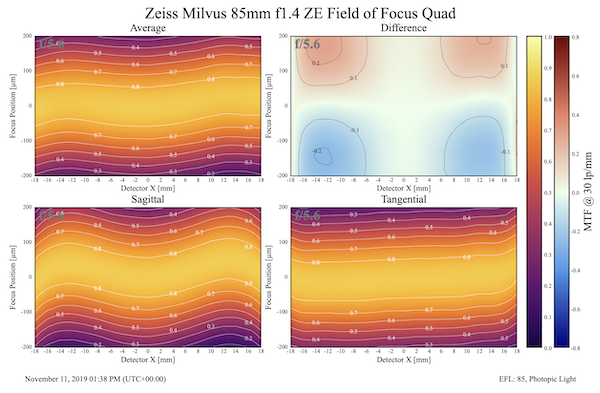
Lensrentals.com, 2020
As we expected, the field curvature is a lot less dramatic here; there’s a very shallow M curve of the sagittal and a nearly perfectly flat tangential.
Canon 85mm f1.4 IS L

Lensrentals.com, 2020

Lensrentals.com, 2020
The Canon has a similar sagittal field, with a very shallow inverse “U” curve of the tangential. The difference graph shows that away from the focus, there is more astigmatism with this lens.
Sony 85mm f1.4 GM
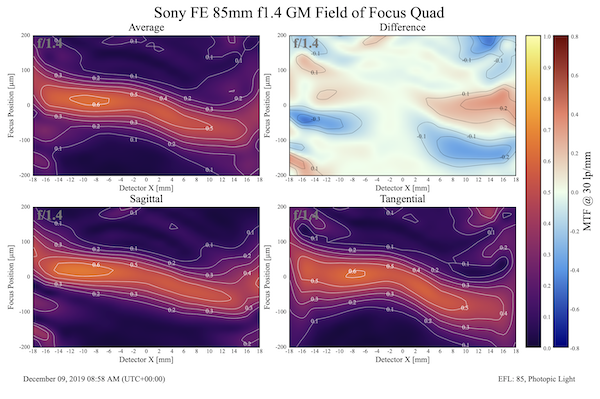
Lensrentals.com, 2020

Lensrentals.com, 2020
The slight tilt and decentering of this copy gives a bit of artifact, but you can see there’s a very shallow U in the sagittal field, a similar inverse U in the tangential. There’s a very good overlap to the very edges of the image.
Nikon 85mm f1.4 G

Lensrentals.com, 2020

Lensrentals.com, 2020
Canon 85mm f1.8
I thought I’d throw and older, cheap design in with these other lenses just for comparison purposes.
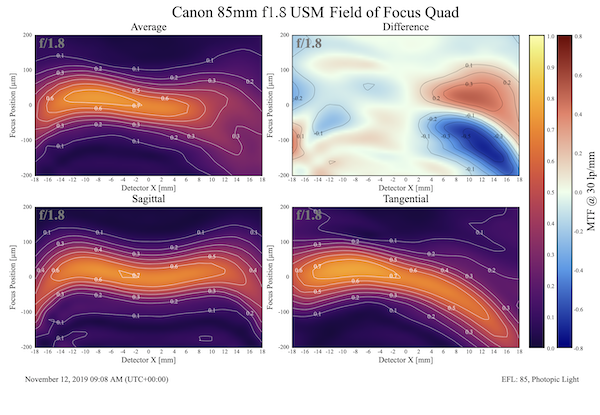
Lensrentals.com, 2020

Lensrentals.com, 2020
The 85mm ‘Look’
Here are the f5.6 tangential and sagittal fields for each lens put into one image for comparison purposes. I think this shows that 85mm prime lenses have more similar field curvatures than the wide-angle lenses did and that the curvature is more regular and less dramatic.

Lensrentals.com, 2020
So What Did We Learn Today?
Well, first and foremost, for a guy that is perceived as ‘all about the sharpness,’ I’ve spent the last few posts saying, “all these lenses are sharp enough for whatever you want to shoot, but there’s more to it than that.” I think the lab has done a good job of showing you several things.
First is that some lenses, no matter how stopped down, have field curvatures that show you will always have some astigmatism, and the edges may never get as sharp as the center. Most of you already knew that, though.
I think today’s exercise also explains why I love short telephoto lenses; the field curvatures are predictable and as near to flat as we’re going to see. My photographic technique with any 85mm is the same no matter which 85mm I’m using.
With wider angle lenses, I try to know the lens and frame the photograph to its strengths. Wide-angle lenses aren’t nearly as predictable, and there’s no way you’re going to get, say, a flat architectural feature in best sharpness from one edge to the other. Sharp enough? Sure. Best sharpness? Absolutely not.
My own technique is to use areas of best sharpness and contrast to emphasize things in my photos, so I really have to learn the foibles of whatever 24mm I’m shooting with, and they aren’t just interchangeable. In other words, it takes more photographic skill and practice to make a good shot with a 24mm.
As an aside, this kind of shows why I value what we learn in the lab. The Sigma 24mm Art has a very different field curvature than the Canon or Nikon 24mm. Most of us, though, won’t get past the ‘I just didn’t like the look’ stage of it, though. The field curvatures may show why someone shooting one of these gets frustrated when first trying another; you need to frame your shots differently to get the most out of the lens.
What about other focal lengths, you ask? Well, here are a bunch of 50mm primes; some old designs, and some new. Take a look, see what you think now that you’ve been comparing field charts. Some are nearly as flat as 85mm lenses; others have quite a bit of curvature.

Lensrentals.com, 2020
What do I notice? Well, the fields are calmer, more like 85mms than the wide-angle lenses. The two Sony designs have different sagittal fields, while all the others have a ‘shallow M’. In the tangential fields, there’s more variation. The Milvus 50mm f/2 has a V shape that mirrors its sagittal field very well, while the Milvus 50mm f/1.4 has a wavy tangential field that is quite different from the sagittal field. The Sony 55mm has a similar tangential, but it lines up better with the sagittal field. The Sigma Art’s “W” shape tangential field that gives that ‘mid outer’ astigmatism pattern.
And here are a number of 35mm lenses. Again, the amount of field curvature varies greatly. You should be drawing your own conclusions by now.

Lensrentals.com, 2020
You’ve lived this long without needing any of it, obviously. But when you decide on a lens, knowing how the field curvature behaves will help you decide what that lens can (and can’t) do well. It also shows why sometimes you want to move back and use the longer focal length to get everything in focus on a plane, and other times when the field curvature can help you isolate your subject. It may tell you when the far edges of your image will be sharper than the mid-outer portion; or that you want to avoid out of focus highlights in certain areas of the field of view.
Or maybe it just confuses the hell out of you. If that’s the case, I continue to make the point I’ve been trying to make for a couple of years. There’s no “it scores a 79; it’s the best lens” in real life. They are tools, and each is a bit different. How well you know and use your tool has more to do with how good (or not) your images are than what it scored on the latest review. You don’t need fancy lab tests to figure that out, you need some time and taking a lot of images with the lens.
Here is an interesting aside that matters for both people who love to compare sharpness lab tests before purchasing a lens, and for those who think examining other’s photographs gives more information. With the standard range and short telephoto lenses, a sharper lens almost always results in sharper photos; other than basic technique (focusing, duration, etc.), the image will have little to do with things. What the lab test tells you and what photographs show you should agree.
When you get into wide-angle lenses, however, the photographer’s skill and experience have much more to do with how awesome that image looks and the lens less. Let’s say, for example, a skilled photographer who has used a Canon 24mm f/1.4L for quite a while reviews other 24mm lenses. Chances are good they would prefer the Nikon or Sony lenses, which have similar strengths and weaknesses they are used to, and they would be less likely to love the very different Zeiss Milvus. And, with the wider lenses, what the lab tests tell you and what the photographer shows you may be quite different.
Roger Cicala
Lensrentals.com
January, 2020
Author: Roger Cicala
I’m Roger and I am the founder of Lensrentals.com. Hailed as one of the optic nerds here, I enjoy shooting collimated light through 30X microscope objectives in my spare time. When I do take real pictures I like using something different: a Medium format, or Pentax K1, or a Sony RX1R.
-
Stefan
-
Mark Rustad
-
chriswilliams
-
Kotlet
-
Roger Cicala
